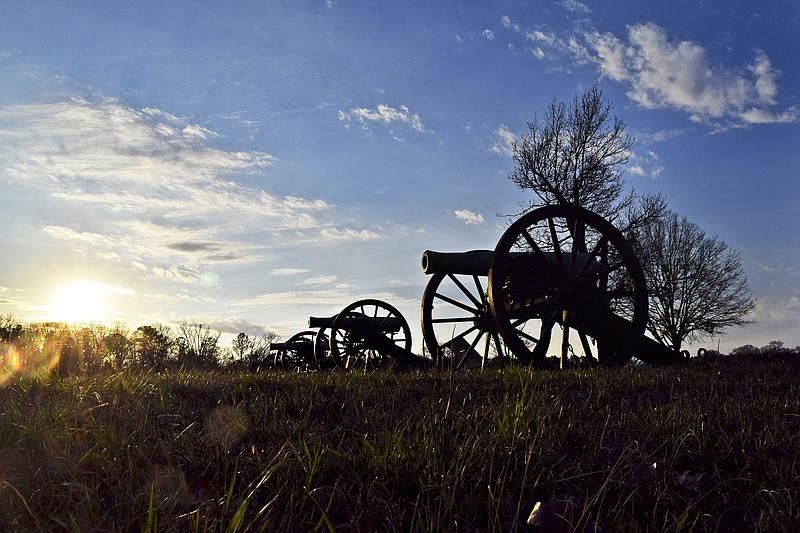With all the hullabaloo about tearing down, moving or covering statues that might in any way refer to figures in the Confederate Army that represented one side in the Civil War, it it interesting to note how the National Park Service handled the issue.
Instead of erasing every trace of representation by one side, it sought to broaden the bigger picture in its national military parks with displays about slavery and its role in the war.
In general, that's a smarter way to go than attempting to pretend Civil War figures didn't exist.
At the Chickamauga Battlefield Visitors Center, for instance, prominent on the left wall of the main corridor just inside the geodesic glass entrance, are such broader displays. Indeed, visitors won't find out much about the battle that took place in the area in that corridor, but they will be able to immerse themselves in a carefully selected version of the main cause of the war.
The National Park Service changes, encouraged by language inserted into a 2000 Department of Interior appropriations bill by then-U.S. Rep. Jesse Jackson Jr., D-Ill., have been somewhat controversial. Many Civil War purists have felt the broadened picture watered down the importance of the battlefields themselves.
One of the historians selected to reinterpret the war, Eric Foner, spoke of his role at a 2000 symposium, "Rallying on the High Ground: Strengthening Interpretation of the Civil War Era," which was held at Ford's Theatre in Washington, D.C., site of the assassination of President Abraham Lincoln.
"In the course of the past 20 years," he said, "American history has been remade. Inspired initially by the social movements of the 1960s and 1970s - which shattered the consensus vision that had dominated historical writing - and influenced by new methods borrowed from other disciplines, American historians redefined the very nature of historical study."
In a book issued following the symposium, Jackson termed the reinterpretation of battlefields "from the African Americans' perspective" as "a down payment on reparations."
According to a 2003 commentary by Patrick J. Buchanan, it was expected to cost $95 million to make the Gettysburg National Military Park politically correct. An estimate at the time put the total cost to taxpayers for changes at all such parks between $300 to $500 million.
We can't imagine that such outlandish sums were spent at the Chickamauga Battlefield Visitors Center - and Park Services officials have said in the past that any such changes weren't mandated - but what was erected may help broaden the concept of, if not remake, the image of the war for those who arrive without much knowledge of it.
The park's programming reflects the broadened view, too. Recent programs, for example, have included "Deeper into Slavery," "The Shadow of Nat Turner," "To the Mountaintop: Emancipation in Chattanooga," and "A Tale of Two Coles: Robert and Thomas Coles at Chickamauga."
Despite the broadened displays and programming, though, the local military park does not attract a significant number of black visitors, according to a 2014 Chickamauga and Chattanooga National Military Park Visitor Study by the National Park Service.
Ninety-five percent of visitor groups were white, according to the study, 2 percent were Asian, 1 percent were American Indian or Alaska natives, 1 percent were black, 1 percent were more than one race and less than 1 percent were native Hawaiian or Pacific islander.
As to what visitor groups learned, the enhanced information imparted on slavery and its place in the war apparently had some effect. It was sixth on the list of importance behind events of the Civil War, events of the campaign for Chattanooga, natural setting where events occurred, impact of the Civil War on American history and impact of the Civil War on civilian life.
As to the importance of topics they learned about, 52 percent of visitor groups said the roles of slavery in causing the Civil War were "extremely important." Only 1 percent thought they were "not at all important." However, of the topics the groups felt there was "too much" information on, the roles of slavery in causing the Civil War topped the list.
About stories that needed to be emphasized or strengthened in the park, groups listed the need to "elaborate on causes/justification/grievances for both North and South" as second on the list behind "none/everything good/well-presented." Fifth on the list was the role of African-Americans.
What would happen if Southern cities took the advice of the National Park Service? What if, beside each monument or statue, there was explanatory wording about the individual figure's role in the war, the city's slave-holding past or its role in the emancipation of slaves? What if descendants of slaves and slave-holders could write the wording together? What if each statue and each monument could be a teaching moment instead of a divisive symbol?
What if racial hatred could be refocused into Americans working together to accomplish things for Americans? We hope that day hasn't passed.
